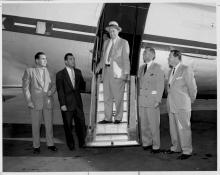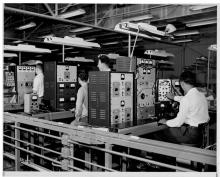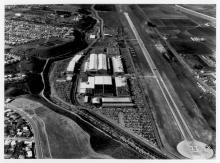Collection Paragraphs
Hughes Aircraft and Electronics
"The trouble with my life is that I do not think I am cut out to sit behind a desk. I would probably be much happier if I were a pilot working for some small airline simply trying to do my job as well as possible. But, of course, such a thing could never happen because when you become wound up in the web of industry to the extent that I am unfortunately you just can't resign the way you can from a country club."

Hughes Electronics was the child of Howard Hughes the Aviator, as opposed to Howard Hughes Movie or Hotel/Casino Mogul. In 2003, Special Collections received from Hughes Electronics Corporation their corporate archives.
Howard Hughes took over control of Hughes Tool Company in 1924 at the age of 19, after his father's death. In 1932 he formed Hughes Aircraft as a division of Hughes Tool Company, essentially to keep track of the expenses of his personal interest in flying and aircraft. This personal passion for flying and developing experimental aircraft established Hughes as a celebrity test and racing pilot, as he set one speed record after another. His company won defense contracts during the war to develop high speed pursuit and reconnaissance aircraft and communication systems, most of which never went beyond prototypes and never entered production. Perhaps the most famous of these experimental prototypes was the HK- 1 Flying Boat, better known as the 'Spruce Goose', the gargantuan wooden cargo plane that Hughes himself piloted on its brief and only flight of one mile, 70 feet above Long Beach Harbor in 1947. Also in that year, and of far greater and lasting importance, the Radio Department of Hughes Aircraft formally morphed into the Electronics Department, where the future of Hughes engineering lay.
Hughes had attracted a number of stellar engineers and scientists from Cal Tech to lead his research and development teams headquartered in a plant in Culver City, California. But by 1953 most of his top management team had walked out, citing difficulties in working with Hughes, whom they characterized as an obsessively controlling, albeit hopelessly indecisive, micromanager. Because Hughes Aircraft at the time had a number of critical defense contracts, the 'disruption' in the corporate management (referred to internally as the Revolt at Culver City) alarmed the Secretary of the Air Force, who essentially gave Hughes an ultimatum that either he remove himself from the any personal role in the management of the company (of which he had made, according to the Secretary, "a hell of a mess") or he would cancel all Air Force contracts with Hughes Aircraft.

Hughes turned over the electronics portion of Hughes Aircraft to the Howard Hughes Medical Institute, and in 1954 Pat Hyland took over control of Hughes Aircraft as Vice-President and General Manager. Under Hyland's direction, Hughes Aircraft became a leader in avionics, developing radar, guided missiles and missile and weapons guidance systems, the synchronous orbit communications satellite, and the Surveyor Lunar aircraft. When Hughes died in 1976, Hyland became the company's president and CEO.
In 1985 Hughes Aircraft was sold to General Motors and became GM-Hughes Electronics Corporation, a wholly owned subsidiary of General Motors. During the 1980s and '90s Hughes Electronics pioneered in telecommunications and satellite and network systems. In 1994 Hughes launched DirectTV in Jacksonville, Mississippi, and in 1995 DirectTV went global
In the late 90s the various Hughes companies had gone through realignments, reorganizations, mergers and spin-offs. Space and Communications were sold to Boeing, Hughes Helicopter to McDonnell-Douglas, and Delco Electronics to General Motors Delphi Automotive. The Summa Corporation, a holding company formed in 1972 to manage Hughes remaining investments, now primarily developed and managed Hughes's enormous real estate holdings on the west side of the Las Vegas valley. Hughes Electronics concentrated on consumer satellite service, DirectTV, DirectPC, and Spaceway, a broadband satellite system.

The Archives of Hughes Electronics Corporation contain the files and publications of the corporate communications department and include complete files of its corporate newsletters Hughes News, 1948-95, and Hughes Herald, 1996-7; press releases, 1956-96; Annual Reports; technical, informational and marketing publications; videos; corporate speeches; biographical files of executives; historical bio files; and photographs of Howard Hughes and aircraft (particularly the 'Spruce Goose'), developed by Hughes Aircraft and test flown by Howard Hughes.
The collection comprises approximately 125 cubic feet of material including large framed portraits of Hughes and corporate presidents. This collection provides unique and comprehensive internal documentation of one of the United States' most influential engineering firms for almost a half-century and for the whole period of its independent existence. As such it was the center of Hughes's corporate empire, and the company with the greatest and most long term impact in engineering, where Hughes's genius in fact lay. The Hughes engineering companies developed aircraft, helicopters, electronics and communications equipment and networks that still hold primary place in American industrial and commercial engineering. It also forms a significant historical record of the legacy of American icon, Howard Hughes.
Unrest in Culver City
(1) His importance in the hush-hush field of guided missiles is so great that the Secretary of the Air Force flies to his side when troubles arise. (2) ...rumor goes ...the Secretary... would love to have him out of the field entirely.
(1) This sentence is too exaggerated. It should be that the Sec'y of the Air Force came to California to see him when there was some rumor of unrest in his plant.
(2) Should be deleted. That is bad. I don't want him to have anything he can use against me. They have Fortune and Life on their side - and they are trying for Time. Anything you say here to support his cause is going to be damaging to me. It is my contention that nobody in the Air Force has anything but praise for the plant except him.
